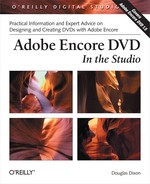Now that you have used Adobe Encore DVD to create timelines from your imported clips and design DVD menus, it’s time to link the menus and timelines together and assemble the navigational flow of your disc. You already know that you can link from buttons to menus, from menus to clips, from menus to other menus, and from clips to other clips. However, you can do much more than that. You can also use links to set the audio and subtitle tracks that your timelines will use. You can get creative with the override links we saw earlier by defining alternate paths that reuse the material in your project. You can even present clips in different ways by creating playlists that iterate through clips in different orders.
In addition, Encore provides powerful tools for checking your project’s navigational design. You can review list views of your project assets, including menus, buttons, timelines, and chapters. And you can use the Check Project tool to have Encore examine your navigational structure for broken or missing links.
Navigational links on a DVD are more than just menus and buttons. Links can be explicitly selected by the viewer from a menu, can default at the end of playback, or can activate automatically after a period of time. Links can also set local attributes such as menu button highlighting, as well as global disc attributes such as audio and subtitle streams.
Encore provides a variety of very different interfaces for setting links, from quick drag-and-drop and menu selections to specific selections using a pick whip or dialog listing all possible targets in the project. All links are set in the Properties palette for the associated project element: menu button, menu, timeline, or disc. To see a full link setting, just over the cursor over the field in the Properties palette and Encore will display the entire link in the pop-up tooltip.
Let’s review the types of links that we’ve encountered so far.
A navigational link can jump to one of several types of targets:
A link can jump to a menu to display that menu. The link also can specify that a specific button on the menu be highlighted as the default selection, or else the default button specified for that menu is used.
A link can jump to a timeline to play the contents of the timeline. The link can also specify that playback begins at a specific chapter point within the timeline, or else it will default to Chapter 1 at the beginning of the timeline.
A link can jump to a playlist to automatically play through a list of timelines (each with an associated starting chapter point).
End actions associated with menus and timelines are also links. We saw these briefly in Chapter 4 and Chapter 5. End action links are set in the associated Properties palette:
Besides defining the destination target for navigation, links can modify two other global settings for playback:
A link can specify the indices of the audio track (1 to 8) and subtitle track (1 to 32, or Off) to be used for further playback, or the tracks can remain unchanged.
A link can specify an override, which is a navigational link that will be remembered while the destination menu or timeline is played, and then performed as the end action instead of the default defined for the destination.
In addition to the links used to control the navigation within a DVD, three other external links control the DVD behavior in response to user actions:
The First Play is the initial action performed when the user inserts a DVD into a player. You can also specify the initial audio and subtitle tracks for the disc. This is set in the Properties palette for the Disc.
The Title button on the remote control is intended to return the viewer to the beginning of the disc, restarting playback. This is also set in the Properties palette for the Disc.
The Menu button on the remote control is intended to jump back to the menu for the current section of the disc. This is set in the Properties palette for each timeline.
By combining these options, you can create designs that range from a straightforward DVD that responds helpfully to user actions, to a self-running DVD that automatically selects menu actions and plays clips. You also can also build nested menu structures that users can navigate hierarchically (e.g., up to the next nested menu), or more free-flowing designs that a user can browse dynamically (e.g., back to the previously viewed item).
